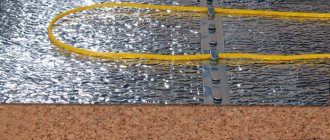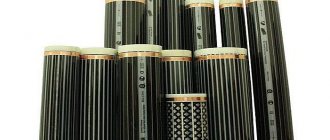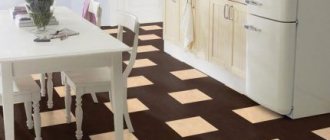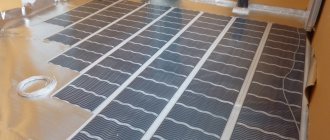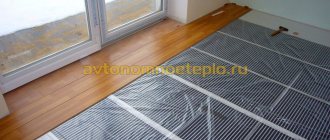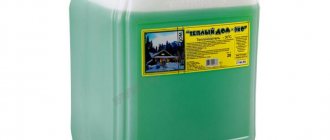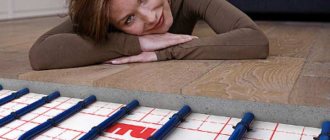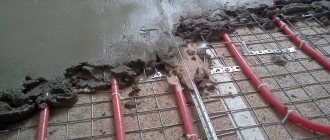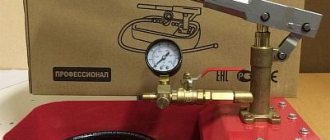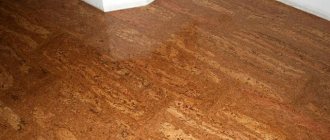Today, the underfloor heating system is extremely popular. This is due to a large number of positive qualities, as well as the possibility of installing any type of flooring. In addition, you can choose absolutely any option for the heating system, depending on the need and the room itself. But it is worth noting that when installing all components of a heated floor, special attention should be paid to the thermal insulation layer so that heat is not wasted just like that. An excellent option here would be underfloor heating. The main thing is to know which one to choose.
Substrate requirements
Many questions immediately arise. Foil in the construction of a heated floor. Does it work or not? Which one is needed or not? How do different types of screeds affect the operation of a heated floor? Infrared radiation or thermal conductivity? The rate of reaction of the heated floor to changes in coolant temperature.
The main material for underfloor heating is polypropylene, foamed polyethylene. They are covered with lavsan film having a metallized layer. The latter serves for uniform heat distribution. All other components do not allow heat to escape to the floors below, but are completely transferred into the room to warm the air from the base of the floor.
The porous underfloor heating substrate has very high permissible temperatures, reaching up to 90 degrees. This allows heating elements to be laid directly on the film. All this indicates the excellent thermal and waterproofing qualities of the material. In addition, there are other qualities that the substrate has - sound insulation and a high degree of reflection.
Each element of the substrate for pouring the floor has a special marking resembling a grid. This facilitates quick and high-quality distribution of the heating cable of an electric heated floor over the surface, depending on the step that is selected.
The substrate allows you to save about 80-90% of thermal radiation. In this case, all energy costs are reduced to a minimum.
Properties
Basic requirements for materials used for laying heated floors:
- strength;
- low level of thermal conductivity - they must insulate well and prevent the heat emanating from the pipes from escaping into the basement or foundation;
- ability to withstand high temperatures up to 90°;
- resistance to temperature changes;
- waterproofing properties;
- environmental friendliness.
Purpose
The underlay is placed between the concrete surface in the room and the heating system. The main purpose of the material is to prevent the loss of heat that comes from the heating elements of the heated floor. Otherwise, the heat will be wasted without showing any effect. This way, only the ceiling on the floor below will warm up. If the substrate is chosen correctly, then heating of the subfloor will not only be uniform, but also twice as fast.
Another purpose of this material in a heated floor system is as a barrier. It does not let in cold, moisture, or steam from the lower floors. This is especially true for the first floors above basements. Since the substrate has excellent soundproofing qualities, in apartment buildings you will not have to listen to screams and noise from neighbors. Other materials can be used for the substrate:
- Cork.
- Fiberboard.
- Foamed polymer.
- Penofol.
- Foil material.
- Extruded polystyrene foam.
But even this cannot be called an exceptional option. Technologies do not stand still and materials are constantly being improved, which can be chosen as a substrate for electric heated floors. The choice of a specific material will depend on the levelness of the base, where the installation is carried out, as well as on the type of floor covering in the finishing.
Installation
You should start by preparing the foundation. There should be no defects, unevenness, debris, or other similar difficulties. The panels themselves are brought into the room a week before installation. They gradually warm up, obtaining the desired level of acclimatization. That is, they are prepared for installation.
Fastening with glue means gradually filling the area from the center of the room. The surface there is 100% dry. As it fills, the heating will dry out the corners. The method always works.
The adhesive mixture should be applied to the base and slabs. Installation is carried out parallel to long walls. First, one half of the room is filled. The interlocking panels fit easily even without a cork floor heating system.
To improve the final quality, a polyurethane backing is implied. The process starts from windows to doors. The parts are connected at an angle of 30 degrees. Detailed instructions are included in the kit. Tapping with a rubber hammer is allowed.
We recommend: How to fill a heated floor?
There should be a gap along the walls. The distance is no more than 1 cm. The ideal option is 8 mm. After heating/humidity, slight deformation will occur. The remaining space is just about to be filled. It is this choice that is correct and provides for reliable fixation.
Underlay for cable floors
The greatest effort for implementation is typical for cable heated floors. After all, here it is mandatory to fill the screed solution. Before installation begins, a number of actions should be carried out, which include:
- If such a need arises, the base where the heated floor system will be installed is leveled. To do this, a rough screed is performed in accordance with all the rules and requirements.
- The installation of a thermal insulation layer, where the choice of substrate is carried out.
- Making a concrete screed for thermal insulation, which will serve as the basis for the heated floor.
After all these measures, you can begin to implement the heating system. The mounting tape is attached to the laid substrate using self-tapping screws. It is in the tape that the heating cable of the heating system is fixed. When the cable is placed on the prepared base, all sensors and cables are fully connected to the electrical network, the concrete screed can be poured.
Particular attention is paid to the substrate. In this option, preference should be given to aluminum foil. Its main task is to efficiently and evenly distribute the heat coming from the heating elements throughout the entire base of the floor. There are two main reasons for this:
- Creating the same temperature level over the entire surface.
- Avoiding local overheating of the heating element. All excess heat must be transferred to a less heated area.
The use of underfloor heating allows you to increase the service life of the entire system. The heating cable can last much longer. It is constantly in operating mode, warming up throughout its entire volume. Many positive qualities are at first glance and invisible from the use of underfloor heating.
It is worth noting that the duration of cooling of the subfloor will depend on the area of its heating. In addition, an increased temperature is provided by the use of a substrate placed under all components of the heating system in the room. It is very important to install it during the installation process. The price is insignificant, but the qualities shown are very high and necessary.
General installation nuances
When installing the substrate under different types of finishing coating, the following installation rules should be taken into account:
- In all cases, the foil reflective surface must face upward. By the way, the substrate for an infrared heated floor with a foil layer is capable of retaining up to 97% of heat flows, which significantly increases the productivity of the installed heated floor.
- The base flooring is laid only using the “end-to-end” method. Metallized tape helps to avoid heat loss in these areas - all substrate connections should be made with it. In addition, such a mount will also act as a barrier to moisture and steam fumes.
- Heating components, regardless of the heat source and the coolant itself, must be installed on top of a layer that will reflect thermal radiation.
Infrared floors
Here we can no longer consider the systems as a classic version. Despite the similar use of the underlay for underfloor heating components, it has a slightly different purpose. After all, infrared film and heating cable have different roles in heat sources. The cable acts directly on the floor, from which the air in the room is heated. Infrared film increases the temperature of the selected floor covering, as well as surrounding objects, which can be furniture, walls, etc. And already from these elements the air in the room begins to warm up.
A waterproofing layer is laid on the existing floor base, on top of which is heat-insulating reflective material. The latter is the substrate for the heated floor system. All that remains is to lay the infrared film. Sheets of film are connected to each other in certain places, after which they are connected to the electrical network.
The substrate of an infrared heated floor has a very important feature - it cannot be foil-coated. Aluminum foil cannot be used as a reflective element. This is fully compatible with the requirements for safe operation of the heating system. If damage occurs to individual sections of the heating elements, a short circuit to the laid substrate may occur.
The underlay for infrared heated floors performs two main functions:
- Thermal insulation.
- Reflects infrared radiation that is directed toward the floor rather than into the room.
The low cost of the substrate allows it to be purchased everywhere and used without fail. In addition, there is a saving of about 30% of the incoming heat. More precisely, losses during the operation of infrared heated floors are reduced.
The main material for the substrate in this case is polymers or foamed polystyrene. The reflective material is metallized lavsan. You can purchase it in the same place where various underfloor heating systems are offered for sale.
At first glance, this requirement is not mandatory when installing infrared heated floors. But the efficiency of the system, as well as the safety of heating in the room, increases significantly. Even a 30% reduction in heat loss for any system will be noticeable and significant. It is very important to fully adhere to the technology during the installation process and follow it from the very beginning to the end.
Reviews
“Is it possible to lay polystyrene foam under heated floors?” Alksey, Tula
"Do not risk. Expanded polystyrene, of course, is a type of foam, but the production technology is completely different, so it is more elastic. The foam is fragile, you won’t even notice the damage, and the heat will escape through the cracks. Nobody forces you to buy a cork (it is only used under expensive laminate or parquet). Take polypropylene, you can’t go wrong, or thicker polyethylene.” Sergey Ivanovich, Zhukovsky
“The floor of the house is icy. The entire foundation fell out. Is it very troublesome to install heated floors?” Gennady, Voronezh
“You can’t make the foundation yet - even with heated floors, it’s troublesome to transport coal by car or pay for gas. Warm floors are still a good thing. The legs are comfortable. Just don’t try to mess with it without a backing – you’ll be heating the street. I watched a smart guy on YouTube and decided to save money on a cheap substrate. I wonder why he needs heated floors at all? We already have global warming, but this smart guy is heating up the street intensely.” Sergey Ivanovich, Zhukovsky
“Don’t you need plastic film for the backing?” Oleg, Vladivostok
"For what? Metallization behind the eyes." Slava, Penza
“People, does anyone know how much a warm water floor will cost?” Alexey, Vologda
“Learn to use Google. Calculate your square meters, the cost of pipes (it’s better to take metal-plastic), substrate, mesh, concrete screed, flooring, and the cost of the work, of course, if you don’t dare to do it yourself.” Sergey Ivanovich, Zhukovsky
- Previous entryInstalling warm water floors under laminate: installation features
Substrate depending on the finish coating
Laminate is the most popular type of floor covering for heated floors. It is distinguished by its low cost and ease of installation. In this case, you should consider purchasing the underlay necessary to separate the covering from the underfloor heating system. Otherwise, there will be a high probability that play will appear in the free areas between the heating elements and the laminate. While walking, this will cause tapping and a certain sound to appear.
The thickness of the laminate underlay is usually 2-5 mm. There is also a specialized material for flooring that has a high level of thermal conductivity. The substrate allows you to solve a number of problems:
- Additional insulation.
- Shock absorber between the coating and the base.
- Leveling out differences. To do this, you should purchase a soft substrate. After all, laminate flooring requires a very even base.
- Preventing damage to laminate elements.
- Avoiding squeaking.
Many manufacturers recommend using rolled polyethylene as a substrate. In addition, it can be combined with concrete mortar and cement. It is able to withstand various chemical influences, as well as the influence of microorganisms that cause the appearance of fungus and mold.
Another option for the substrate is cork, which is sold in rolls or slabs. It is made from pressed chips from cork wood. Preference should be given to rolls by reducing waste during the installation of the entire “pie”. During operation, the cork will not deform and does not shrink. This will all tell you which underlay for laminate flooring to choose.
Another flooring option is linoleum. Here, on the contrary, the substrate under the heated floor should be solid. Otherwise, heavy furniture or constant walking may cause indentations in the base of the floor. An excellent option is fiberboard.
Ceramic tiles are often used. Without a heated floor, it tends to remain cold even in hot weather. In this case, for an electric heated floor, it is best to use a lavsan metallized coating as a substrate. This will allow you to heat the tiles with maximum efficiency. The main thing in this case is to use material of the same thickness.
Prices
The cost of thermal insulation materials can vary significantly and depends on their composition, thickness and manufacturer.
A thin substrate is cheaper, so if pipes are laid on screed or self-leveling floors, with a solid, insulated foundation, it is enough to choose a 3 mm substrate. The width of the roll or tile may also vary from manufacturer to manufacturer.
An overview of the properties of the substrate is presented in this video:
Average prices for underlays for warm water floors, February 2015
| Name | price, rub. per sq. m |
| Foamed polyethylene 3 mm | 8,50 |
| Foamed polyethylene 5 mm | 14,30 |
| Foamed polyethylene 10 mm | 28,00 |
| Foiled polypropylene foam 3 mm | 75,00 |
| Foiled polypropylene foam 5 mm | 79,00 |
| Foiled polypropylene foam 10 mm | 100,00 |
| Cork 4 mm | 270,00 |
| Cork 6 mm | 400,00 |
| Cork 10 mm | 450,00 |
Popular parquet boards: DIY installation in various ways.
You can find out prices for permanent polystyrene foam formwork.
Read about such a simple method of fastening linoleum joints as cold welding in our article.
Installation instructions
- Preparing the concrete base. Filling with liquid screed, leveling.
- The entire surface of the floor must be primed and, if necessary, treated with hydrophobic compounds and a liquid waterproofing agent. An insulating film is pasted around the perimeter of the room, extending onto the walls.
- A damper tape up to 10 cm high must be pasted over the insulation around the perimeter.
- A layer of thermal insulation and a heat-reflecting screen are laid. For uniform installation, double-sided tape can be used between the screen and the concrete base or insulation.
- The perimeter of laying the film heated floor is drawn.
- The underfloor heating elements are laid in the optimal order. Many manufacturers recommend overlapping the width of the laminated edge of the film, which does not have a heating element. All joints are taped with tape.
- A heat-sensitive sensor is mounted and all heating elements are connected to the supply wires. At this stage, you can perform a trial run to determine the adequate operation of the heated floor and make sure there are no defects.
- A substrate is laid under the laminate or polyethylene film. The joints are taped with tape.
- The floor covering is assembled, maintaining a gap between the floor and walls equal to the thickness of the damper tape.
Laying heating elements Having completely assembled the floor covering, installed the baseboard, and after sewing up all the supply wires, you can check the operation of the heated floor, evaluate the reaction speed, inertness, efficiency and uniformity of heating. If everything is fine, then the installation is considered complete.
